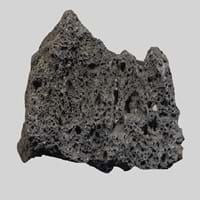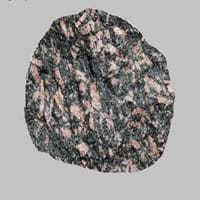Definition
Scoria is a dark-colored extrusive igneous rock with abundant round bubble-like cavities
Luxullianite is a rare type of granite, known for presence of clusters of radially arranged acicular tourmaline crystals which are enclosed by phenocrysts of orthoclase and quartz in a matrix of quartz, tourmaline, alkali feldspar, brown mica.
Discoverer
Unknown
Unknown
Etymology
From late Middle English (denoting slag from molten metal), from Greek skōria refuse, from skōr dung
From the village of Luxulyan in Cornwall, England, where this variety of granite is found
Class
Igneous Rocks
Igneous Rocks
Sub-Class
Durable Rock, Medium Hardness Rock
Durable Rock, Hard Rock
Other Categories
Fine Grained Rock, Opaque Rock
Coarse Grained Rock, Opaque Rock
Texture
Vesicular
Granular, Phaneritic
Color
Black, Brown, Dark Grey to Black, Red
Black, Grey, Orange, Pink, White
Durability
Durable
Durable
Scratch Resistant
Yes
Yes
Appearance
Glassy and Vesicular
Veined or Pebbled
Interior Uses
Decorative Aggregates, Interior Decoration
Bathrooms, Countertops, Decorative Aggregates, Entryways, Floor Tiles, Homes, Hotels, Interior Decoration, Kitchens, Stair Treads
Exterior Uses
Garden Decoration, Paving Stone
As Building Stone, As Facing Stone, Paving Stone, Garden Decoration, Office Buildings
Other Architectural Uses
Curbing
Curbing
Construction Industry
Cement Manufacture, Construction Aggregate, for Road Aggregate, In landscaping and drainage works
As Dimension Stone
Medical Industry
Not Yet Used
Not Yet Used
Antiquity Uses
Artifacts, Monuments, Sculpture
Artifacts, Monuments, Sculpture
Commercial Uses
As a traction material on snow-covered roads, Creating Artwork, High-temperature insulation, In gas barbecue grills
Creating Artwork, Curling, Gemstone, Laboratory bench tops, Tombstones
Types
Not Available
Igneous Protolith Granite, Sedimentary Protolith Granite, Mantle Granite, Anorogenic Granite and Hybrid Granite
Features
Available in Lots of Colors and Patterns, Generally rough to touch, Surfaces are often shiny
Available in Lots of Colors and Patterns, It is One of the Oldest, Strongest and Hardest Rock
Archaeological Significance
Famous Monuments
Data Not Available
Data Not Available
Famous Sculptures
Data Not Available
Data Not Available
Pictographs
Used
Not Used
Petroglyphs
Used
Not Used
Formation
Scoria forms when magma containing huge amount of dissolved gas flows from a volcano during an eruption.
Luxullianite is an intrusive igneous rock which is very hard, crystalline and is visibly homogeneous in texture. It is found in large plutons on the continents, i.e. in areas where the Earth's crust has been deeply eroded.
Mineral Content
Apatite, Biotite, Calcite, Feldspar, Hematite, Hornblade, Ilmenite, Magnetite, Olivine, Pyroxene, Quartz, Silica
Amphibole, Biotite, Feldspar, Hornblade, Micas, Muscovite or Illite, Plagioclase, Pyroxene, Quartz
Compound Content
Ca, NaCl
Aluminium Oxide, CaO, Iron(III) Oxide, FeO, Potassium Oxide, MgO, MnO, Sodium Oxide, Phosphorus Pentoxide, Silicon Dioxide, Titanium Dioxide
Types of Metamorphism
Burial Metamorphism, Cataclastic Metamorphism, Contact Metamorphism
Burial Metamorphism, Cataclastic Metamorphism, Contact Metamorphism, Hydrothermal Metamorphism, Impact Metamorphism
Types of Weathering
Biological Weathering, Chemical Weathering, Mechanical Weathering
Biological Weathering, Chemical Weathering, Mechanical Weathering
Types of Erosion
Chemical Erosion, Coastal Erosion, Glacier Erosion
Chemical Erosion, Water Erosion, Wind Erosion
Grain Size
Fine Grained
Large and Coarse Grained
Fracture
Conchoidal
Not Available
Porosity
Highly Porous
Less Porous
Luster
Subvitreous to Dull
Dull to Grainy with Sporadic parts Pearly and Vitreous
Compressive Strength
Not Available
Cleavage
Perfect
Not Available
Toughness
2.1
Not Available
Specific Gravity
Not Available
2.6-2.7
Transparency
Opaque
Opaque
Density
Not Available
2.6-2.8 g/cm3
Specific Heat Capacity
Not Available
Resistance
Heat Resistant, Impact Resistant, Pressure Resistant, Wear Resistant
Heat Resistant, Wear Resistant
Deposits in Eastern Continents
Asia
Afghanistan, Indonesia, Japan, Russia
China, India, Iran, Saudi Arabia, Sri Lanka, Taiwan, Thailand, Turkey, Vietnam
Africa
Ethiopia, Kenya, Tanzania
Angola, Egypt, Madagascar, Namibia, Nigeria, South Africa
Europe
Greece, Hungary, Iceland, Italy, Turkey
Austria, Belgium, Finland, France, Germany, Italy, Norway, Sardinia, Spain, Switzerland, The Czech Republic, Venezuela
Others
Not Yet Found
Not Yet Found
Deposits in Western Continents
North America
Bahamas, Barbados, Canada, Costa Rica, Cuba, Jamaica, Mexico, USA
Canada, USA
South America
Argentina, Chile, Ecuador, Peru
Not Yet Found
Deposits in Oceania Continent
Australia
New Zealand, Western Australia
Not Yet Found
Scoria vs Luxullianite Characteristics
Though some rocks look identical, they have certain characteristics which distinguish them from others. Characteristics of rocks include texture, appearance, color, fracture, streak, hardness etc. Scoria vs Luxullianite characteristics assist us to distinguish and recognize rocks. Also you can check about Properties of Scoria and Properties of Luxullianite. Learn more about Scoria vs Luxullianite in the next section. The interior uses of Scoria include Decorative aggregates and Interior decoration whereas the interior uses of Luxullianite include Bathrooms, Countertops, Decorative aggregates, Entryways, Floor tiles, Homes, Hotels, Interior decoration, Kitchens and Stair treads. Due to some exceptional properties of Scoria and Luxullianite, they have various applications in construction industry. The uses of Scoria in construction industry include Cement manufacture, Construction aggregate, For road aggregate, In landscaping and drainage works and that of Luxullianite include As dimension stone.
More about Scoria and Luxullianite
Here you can know more about Scoria and Luxullianite. The life cycle of a rock consists of formation of rock, composition of rock and transformation of rock. The composition of Scoria and Luxullianite consists of mineral content and compound content. The mineral content of Scoria includes Apatite, Biotite, Calcite, Feldspar, Hematite, Hornblade, Ilmenite, Magnetite, Olivine, Pyroxene, Quartz, Silica and mineral content of Luxullianite includes Amphibole, Biotite, Feldspar, Hornblade, Micas, Muscovite or Illite, Plagioclase, Pyroxene, Quartz. You can also check out the list of all Igneous Rocks. When we have to compare Scoria vs Luxullianite, the texture, color and appearance plays an important role in determining the type of rock. Scoria is available in black, brown, dark grey to black, red colors whereas, Luxullianite is available in black, grey, orange, pink, white colors. Appearance of Scoria is Glassy and Vesicular and that of Luxullianite is Veined or Pebbled. Properties of rock is another aspect for Scoria vs Luxullianite. The hardness of Scoria is 5-6 and that of Luxullianite is 6-7. The types of Scoria are Not Available whereas types of Luxullianite are Igneous Protolith Granite, Sedimentary Protolith Granite, Mantle Granite, Anorogenic Granite and Hybrid Granite. Streak of rock is the color of powder produced when it is dragged across an unweathered surface. The streak of Scoria and Luxullianite is white. The specific heat capacity of Scoria is Not Available and that of Luxullianite is 0.79 kJ/Kg K. Depending on the properties like hardness, toughness, specific heat capacity, porosity etc., rocks are resistant to heat, wear, impact, etc.Scoria is heat resistant, impact resistant, pressure resistant, wear resistant whereas Luxullianite is heat resistant, wear resistant.





